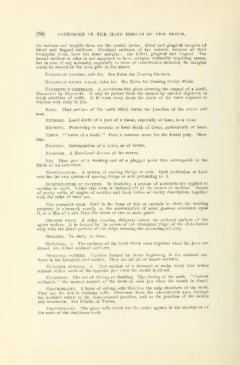Page 556 - My FlipBook
P. 556
298 PATHOLOGY OF THE HABD TISSUES OF THE TEETH.
the incisors and cuspids these are the mesial, incisal, distal and gingival margins of
labial and lingual surfaces. Proximal surfaces of the incisors, because of their
triangular form, have but three margins: the labial, gingival and lingual. The
incisal surface or edge is not supposed to have margins ordinarily requiring names,
but in case of any necessity, especially in cases of considerable abrasion, the margins
would be named on the same plan as the above.
Naming op cavities, rule for. See Eules for Naming Cavities.
Naming of cavity walls, rules for. See Eules for Naming Cavity Walls.
Naysmith 's membrane, a membrane-like glaze covering the enamel of a tooth,
discovered by Naysmith. It may be parted from the enamel by careful digestion in
weak solutions of acids. It is worn away from the parts of the teeth exposed to
friction very early in life.
Neck. That portion of the tooth which forms the junction of the crown and
root.
Necsosis. Local death of a part of a tissue, especially of bone, in a mass.
Necrotic. Pertaining to necrosis or local death of tissue, particularly of bone.
Nerve. ' ' Nerve of a tooth. ' ' Once a common name for the dental pulp. Obso-
lete.
Neuritis. Inflammation of a nerve, or of nerves.
Neurosis. A functional disease of the nerves.
Nib. That part of a working end of a plugger point that corresponds to the
blade of an excavator.
Nomenclature. A system of naming things or acts. Each profession or busi-
ness has its own system of naming things or acts pertaining to it.
Nomenclature of cavities. In dentistry, a system of nomenclature applied to
cavities in teeth. Under this term is included aU of the names of cavities. Names
of cavity walls, of angles of cavities and their terms of cavity description, together
with the rules of their use.
Non-cohesive gold. Gold in the form of foil or crystals in which the welding
property is obscured, usually by the condensation of some gaseous substance upon
it, or a film of a salt from the union of two or more gases.
Oblique ridge. A ridge running obliquely across the occlusal surface of the
upper molars. It is formed by the union of the triangular ridge of the disto-buccal
cusp with the distal portion of the ridge forming the mesio-lingual cusp.
Occlude. To shut; to close.
Occlusal, a. The surfaces of the teeth which come together when the jaws are
closed, are called occlusal surfaces.
Occlusal cavities. Cavities formed by decay beginning in the occlusal sur-
faces in the bicuspids and molars. They are all pit or fissure cavities.
Occlusal surface, n. That surface of a bicuspid or molar tooth that makes
contact with a tooth of the opposite jaw when the mouth is closed.
Occlusion. The act of closing or shutting. The closing of the teeth. ' ' Correct
occlusion," the normal contact of the teeth of each jaw when the mouth is closed.
Odontoblasts. A layer of oblong cells that line the pulp chambers of the teeth.
They are the dentin forming cells. Processes from the odontoblasts pass through
the dentinal canals to the dento-enamel junction, and to the junction of the dentin
and cementum. See Fibrils of Tomes.
0D0NT0CLA.STS. The giant cells which are the active agents in the absorption of
the roots of the deciduous teeth.


